BHP Billiton Business Research Report: Industry and Strategy Analysis
VerifiedAdded on 2019/10/30
|12
|2899
|160
Report
AI Summary
This report provides a detailed analysis of BHP Billiton, a major player in the mining industry. It begins by examining the company's competitive advantages, including its diverse portfolio, sustainability practices, and global presence. The report then delves into the trends within the steel manufacturing industry, highlighting the impact of global steel supply and pricing. A comprehensive overview of BHP Billiton's current business strategies is presented, covering exploration and evaluation, development, marketing and logistics, and sustainability. The report includes both internal (SWOT analysis) and external (PESTLE and micro-environmental) analyses to assess the company's strengths, weaknesses, opportunities, and threats, as well as its relationship with customers, competitors, suppliers, shareholders, and employees. The report concludes by summarizing the key findings and offering insights into BHP Billiton's position in the market.
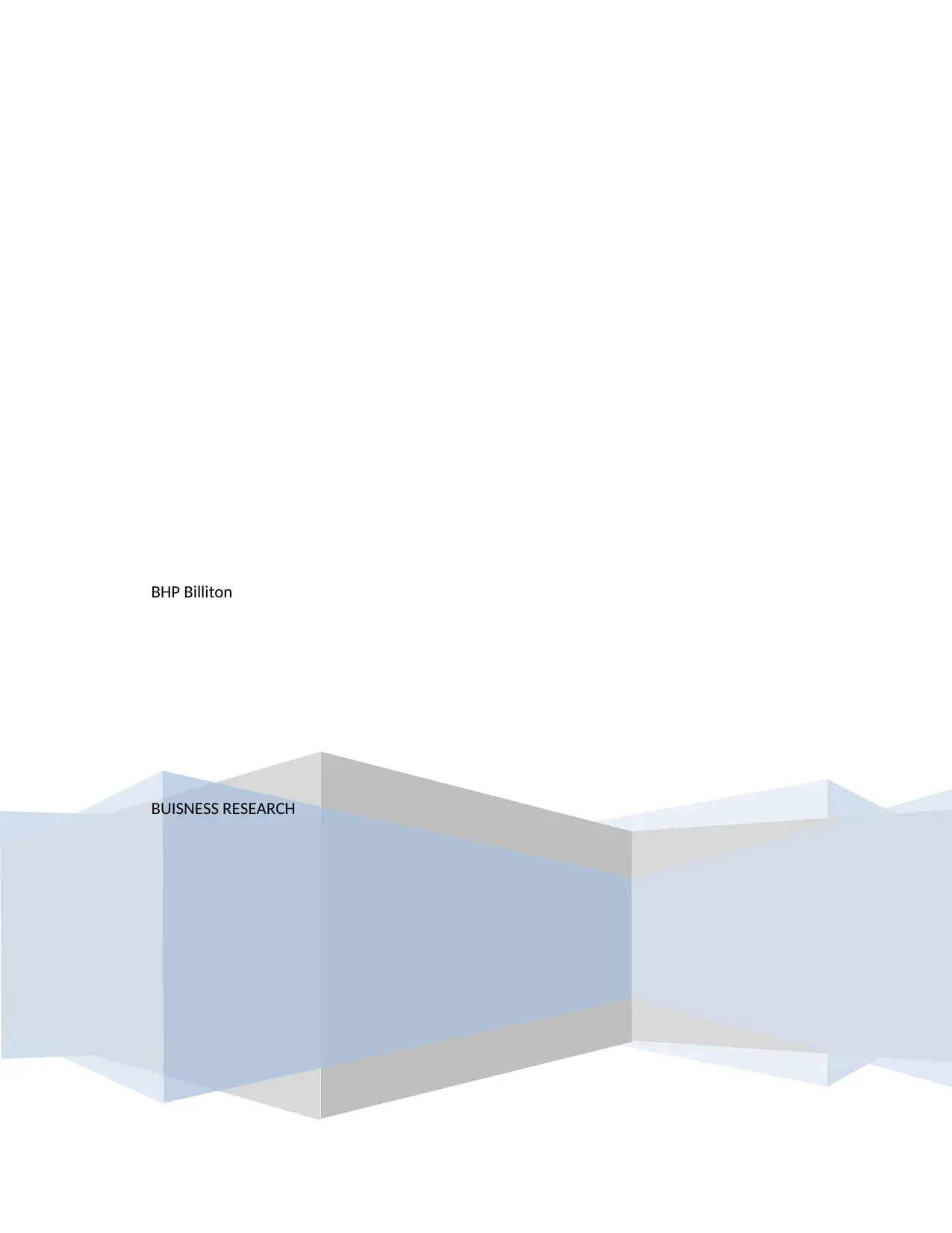
BUISNESS RESEARCH
BHP Billiton
BHP Billiton
Secure Best Marks with AI Grader
Need help grading? Try our AI Grader for instant feedback on your assignments.
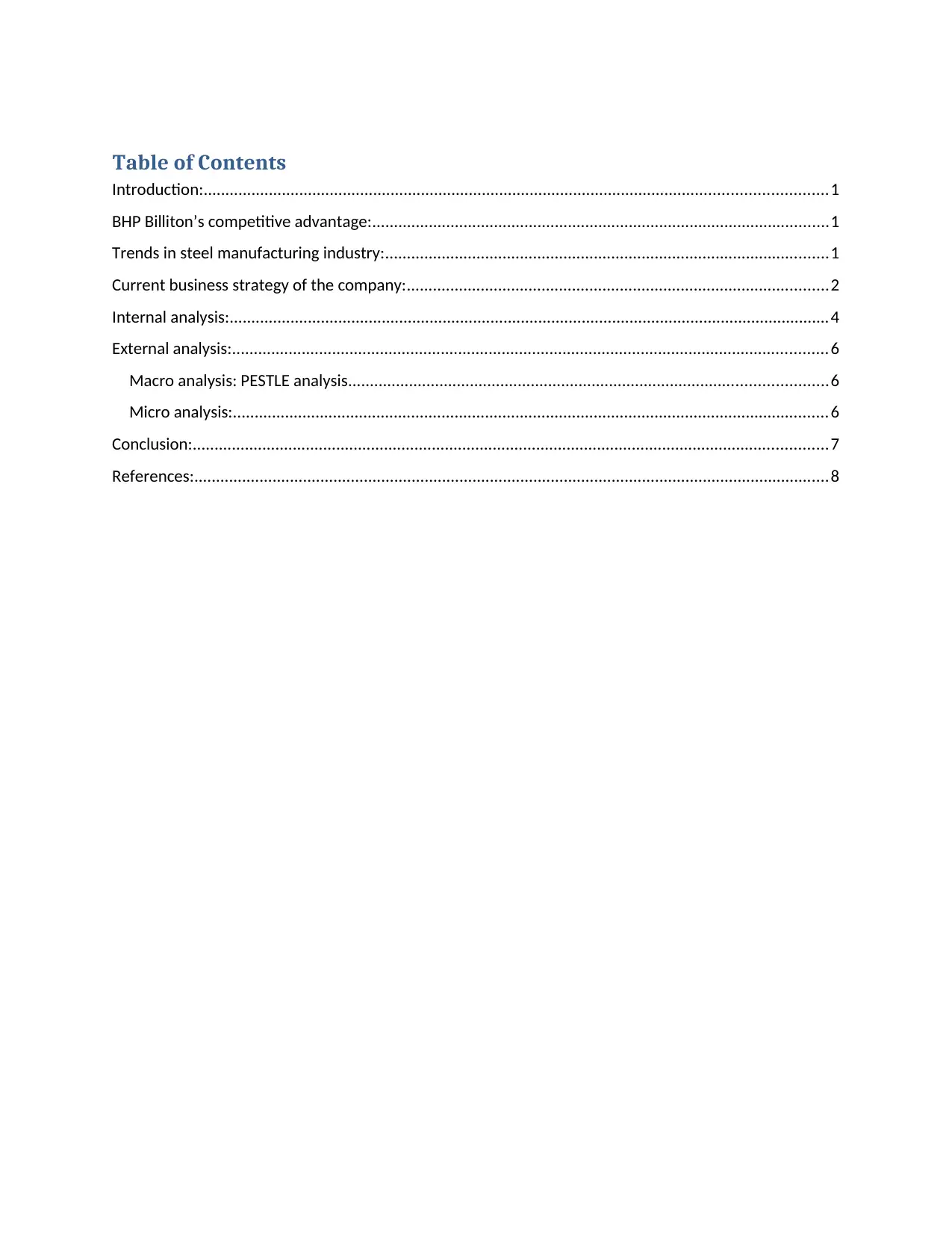
Table of Contents
Introduction:...............................................................................................................................................1
BHP Billiton’s competitive advantage:.........................................................................................................1
Trends in steel manufacturing industry:......................................................................................................1
Current business strategy of the company:.................................................................................................2
Internal analysis:..........................................................................................................................................4
External analysis:.........................................................................................................................................6
Macro analysis: PESTLE analysis..............................................................................................................6
Micro analysis:.........................................................................................................................................6
Conclusion:..................................................................................................................................................7
References:..................................................................................................................................................8
Introduction:...............................................................................................................................................1
BHP Billiton’s competitive advantage:.........................................................................................................1
Trends in steel manufacturing industry:......................................................................................................1
Current business strategy of the company:.................................................................................................2
Internal analysis:..........................................................................................................................................4
External analysis:.........................................................................................................................................6
Macro analysis: PESTLE analysis..............................................................................................................6
Micro analysis:.........................................................................................................................................6
Conclusion:..................................................................................................................................................7
References:..................................................................................................................................................8
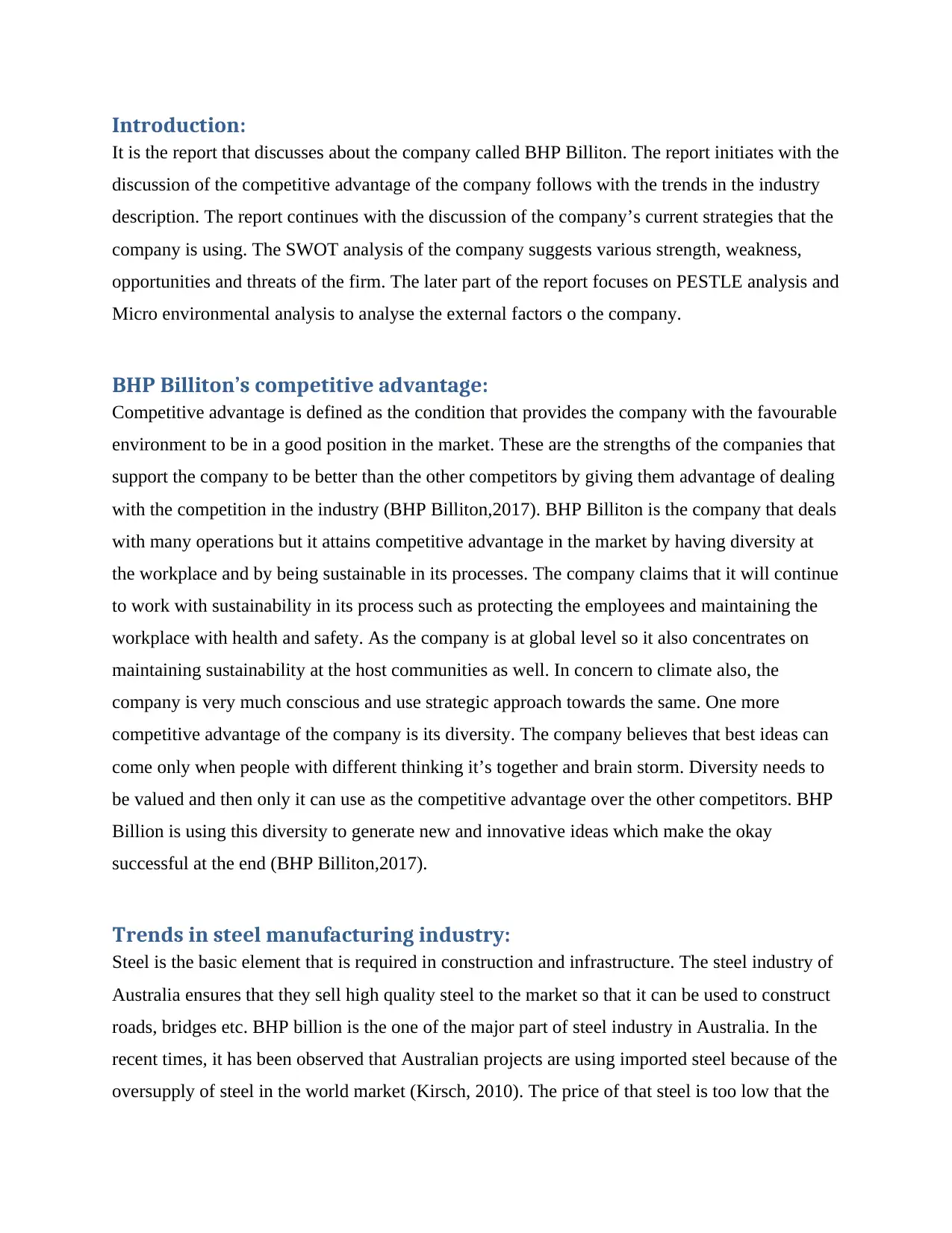
Introduction:
It is the report that discusses about the company called BHP Billiton. The report initiates with the
discussion of the competitive advantage of the company follows with the trends in the industry
description. The report continues with the discussion of the company’s current strategies that the
company is using. The SWOT analysis of the company suggests various strength, weakness,
opportunities and threats of the firm. The later part of the report focuses on PESTLE analysis and
Micro environmental analysis to analyse the external factors o the company.
BHP Billiton’s competitive advantage:
Competitive advantage is defined as the condition that provides the company with the favourable
environment to be in a good position in the market. These are the strengths of the companies that
support the company to be better than the other competitors by giving them advantage of dealing
with the competition in the industry (BHP Billiton,2017). BHP Billiton is the company that deals
with many operations but it attains competitive advantage in the market by having diversity at
the workplace and by being sustainable in its processes. The company claims that it will continue
to work with sustainability in its process such as protecting the employees and maintaining the
workplace with health and safety. As the company is at global level so it also concentrates on
maintaining sustainability at the host communities as well. In concern to climate also, the
company is very much conscious and use strategic approach towards the same. One more
competitive advantage of the company is its diversity. The company believes that best ideas can
come only when people with different thinking it’s together and brain storm. Diversity needs to
be valued and then only it can use as the competitive advantage over the other competitors. BHP
Billion is using this diversity to generate new and innovative ideas which make the okay
successful at the end (BHP Billiton,2017).
Trends in steel manufacturing industry:
Steel is the basic element that is required in construction and infrastructure. The steel industry of
Australia ensures that they sell high quality steel to the market so that it can be used to construct
roads, bridges etc. BHP billion is the one of the major part of steel industry in Australia. In the
recent times, it has been observed that Australian projects are using imported steel because of the
oversupply of steel in the world market (Kirsch, 2010). The price of that steel is too low that the
It is the report that discusses about the company called BHP Billiton. The report initiates with the
discussion of the competitive advantage of the company follows with the trends in the industry
description. The report continues with the discussion of the company’s current strategies that the
company is using. The SWOT analysis of the company suggests various strength, weakness,
opportunities and threats of the firm. The later part of the report focuses on PESTLE analysis and
Micro environmental analysis to analyse the external factors o the company.
BHP Billiton’s competitive advantage:
Competitive advantage is defined as the condition that provides the company with the favourable
environment to be in a good position in the market. These are the strengths of the companies that
support the company to be better than the other competitors by giving them advantage of dealing
with the competition in the industry (BHP Billiton,2017). BHP Billiton is the company that deals
with many operations but it attains competitive advantage in the market by having diversity at
the workplace and by being sustainable in its processes. The company claims that it will continue
to work with sustainability in its process such as protecting the employees and maintaining the
workplace with health and safety. As the company is at global level so it also concentrates on
maintaining sustainability at the host communities as well. In concern to climate also, the
company is very much conscious and use strategic approach towards the same. One more
competitive advantage of the company is its diversity. The company believes that best ideas can
come only when people with different thinking it’s together and brain storm. Diversity needs to
be valued and then only it can use as the competitive advantage over the other competitors. BHP
Billion is using this diversity to generate new and innovative ideas which make the okay
successful at the end (BHP Billiton,2017).
Trends in steel manufacturing industry:
Steel is the basic element that is required in construction and infrastructure. The steel industry of
Australia ensures that they sell high quality steel to the market so that it can be used to construct
roads, bridges etc. BHP billion is the one of the major part of steel industry in Australia. In the
recent times, it has been observed that Australian projects are using imported steel because of the
oversupply of steel in the world market (Kirsch, 2010). The price of that steel is too low that the
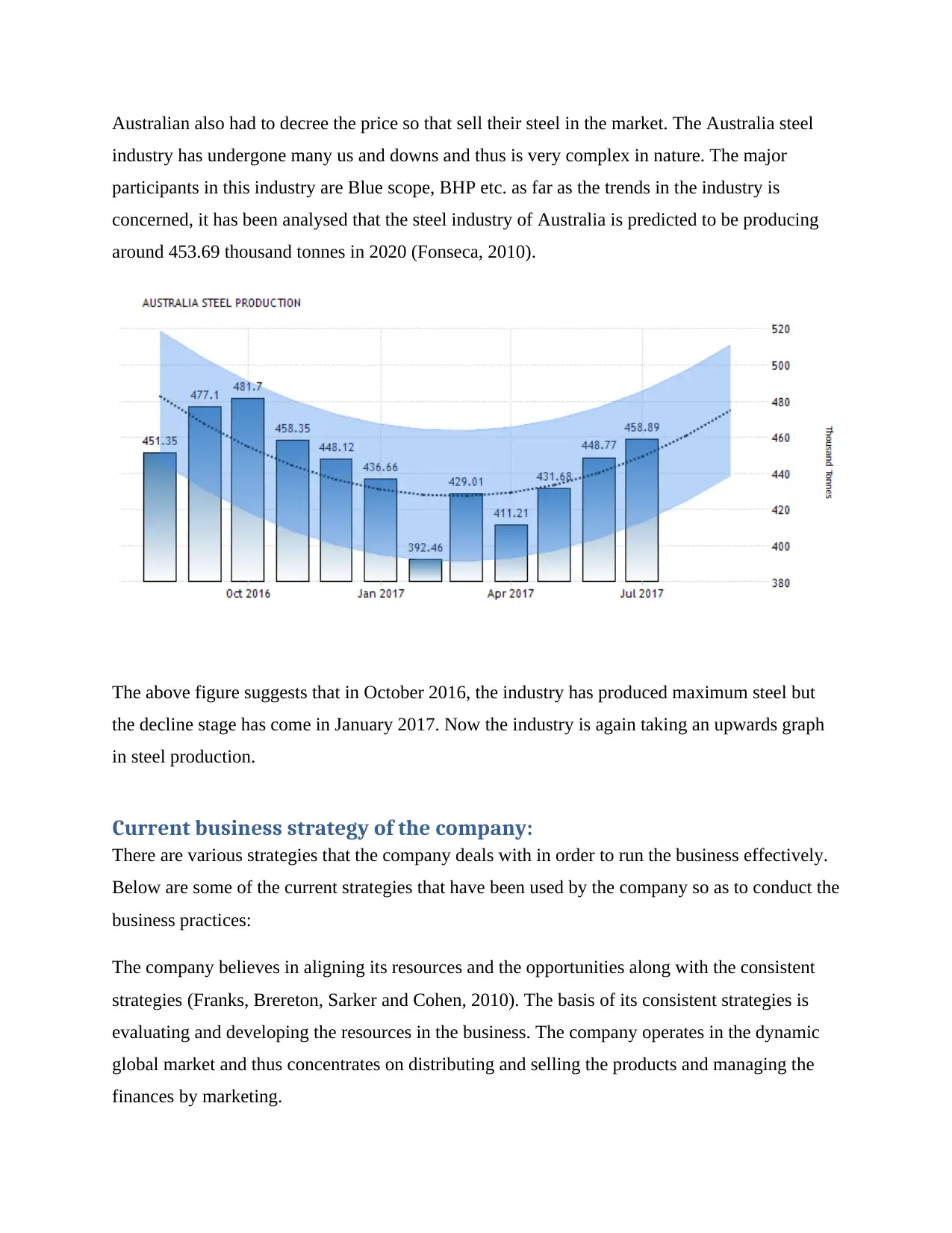
Australian also had to decree the price so that sell their steel in the market. The Australia steel
industry has undergone many us and downs and thus is very complex in nature. The major
participants in this industry are Blue scope, BHP etc. as far as the trends in the industry is
concerned, it has been analysed that the steel industry of Australia is predicted to be producing
around 453.69 thousand tonnes in 2020 (Fonseca, 2010).
The above figure suggests that in October 2016, the industry has produced maximum steel but
the decline stage has come in January 2017. Now the industry is again taking an upwards graph
in steel production.
Current business strategy of the company:
There are various strategies that the company deals with in order to run the business effectively.
Below are some of the current strategies that have been used by the company so as to conduct the
business practices:
The company believes in aligning its resources and the opportunities along with the consistent
strategies (Franks, Brereton, Sarker and Cohen, 2010). The basis of its consistent strategies is
evaluating and developing the resources in the business. The company operates in the dynamic
global market and thus concentrates on distributing and selling the products and managing the
finances by marketing.
industry has undergone many us and downs and thus is very complex in nature. The major
participants in this industry are Blue scope, BHP etc. as far as the trends in the industry is
concerned, it has been analysed that the steel industry of Australia is predicted to be producing
around 453.69 thousand tonnes in 2020 (Fonseca, 2010).
The above figure suggests that in October 2016, the industry has produced maximum steel but
the decline stage has come in January 2017. Now the industry is again taking an upwards graph
in steel production.
Current business strategy of the company:
There are various strategies that the company deals with in order to run the business effectively.
Below are some of the current strategies that have been used by the company so as to conduct the
business practices:
The company believes in aligning its resources and the opportunities along with the consistent
strategies (Franks, Brereton, Sarker and Cohen, 2010). The basis of its consistent strategies is
evaluating and developing the resources in the business. The company operates in the dynamic
global market and thus concentrates on distributing and selling the products and managing the
finances by marketing.
Secure Best Marks with AI Grader
Need help grading? Try our AI Grader for instant feedback on your assignments.
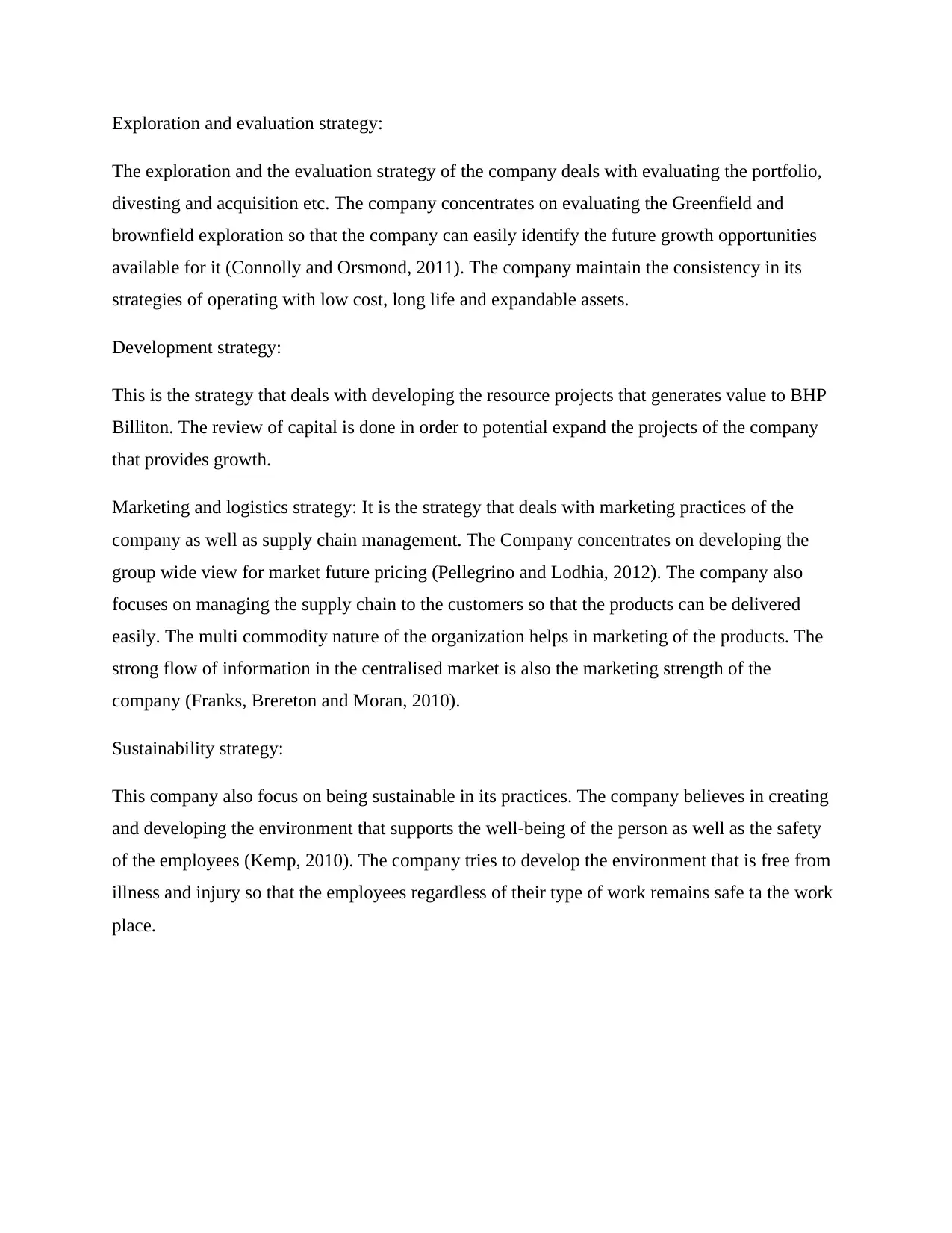
Exploration and evaluation strategy:
The exploration and the evaluation strategy of the company deals with evaluating the portfolio,
divesting and acquisition etc. The company concentrates on evaluating the Greenfield and
brownfield exploration so that the company can easily identify the future growth opportunities
available for it (Connolly and Orsmond, 2011). The company maintain the consistency in its
strategies of operating with low cost, long life and expandable assets.
Development strategy:
This is the strategy that deals with developing the resource projects that generates value to BHP
Billiton. The review of capital is done in order to potential expand the projects of the company
that provides growth.
Marketing and logistics strategy: It is the strategy that deals with marketing practices of the
company as well as supply chain management. The Company concentrates on developing the
group wide view for market future pricing (Pellegrino and Lodhia, 2012). The company also
focuses on managing the supply chain to the customers so that the products can be delivered
easily. The multi commodity nature of the organization helps in marketing of the products. The
strong flow of information in the centralised market is also the marketing strength of the
company (Franks, Brereton and Moran, 2010).
Sustainability strategy:
This company also focus on being sustainable in its practices. The company believes in creating
and developing the environment that supports the well-being of the person as well as the safety
of the employees (Kemp, 2010). The company tries to develop the environment that is free from
illness and injury so that the employees regardless of their type of work remains safe ta the work
place.
The exploration and the evaluation strategy of the company deals with evaluating the portfolio,
divesting and acquisition etc. The company concentrates on evaluating the Greenfield and
brownfield exploration so that the company can easily identify the future growth opportunities
available for it (Connolly and Orsmond, 2011). The company maintain the consistency in its
strategies of operating with low cost, long life and expandable assets.
Development strategy:
This is the strategy that deals with developing the resource projects that generates value to BHP
Billiton. The review of capital is done in order to potential expand the projects of the company
that provides growth.
Marketing and logistics strategy: It is the strategy that deals with marketing practices of the
company as well as supply chain management. The Company concentrates on developing the
group wide view for market future pricing (Pellegrino and Lodhia, 2012). The company also
focuses on managing the supply chain to the customers so that the products can be delivered
easily. The multi commodity nature of the organization helps in marketing of the products. The
strong flow of information in the centralised market is also the marketing strength of the
company (Franks, Brereton and Moran, 2010).
Sustainability strategy:
This company also focus on being sustainable in its practices. The company believes in creating
and developing the environment that supports the well-being of the person as well as the safety
of the employees (Kemp, 2010). The company tries to develop the environment that is free from
illness and injury so that the employees regardless of their type of work remains safe ta the work
place.
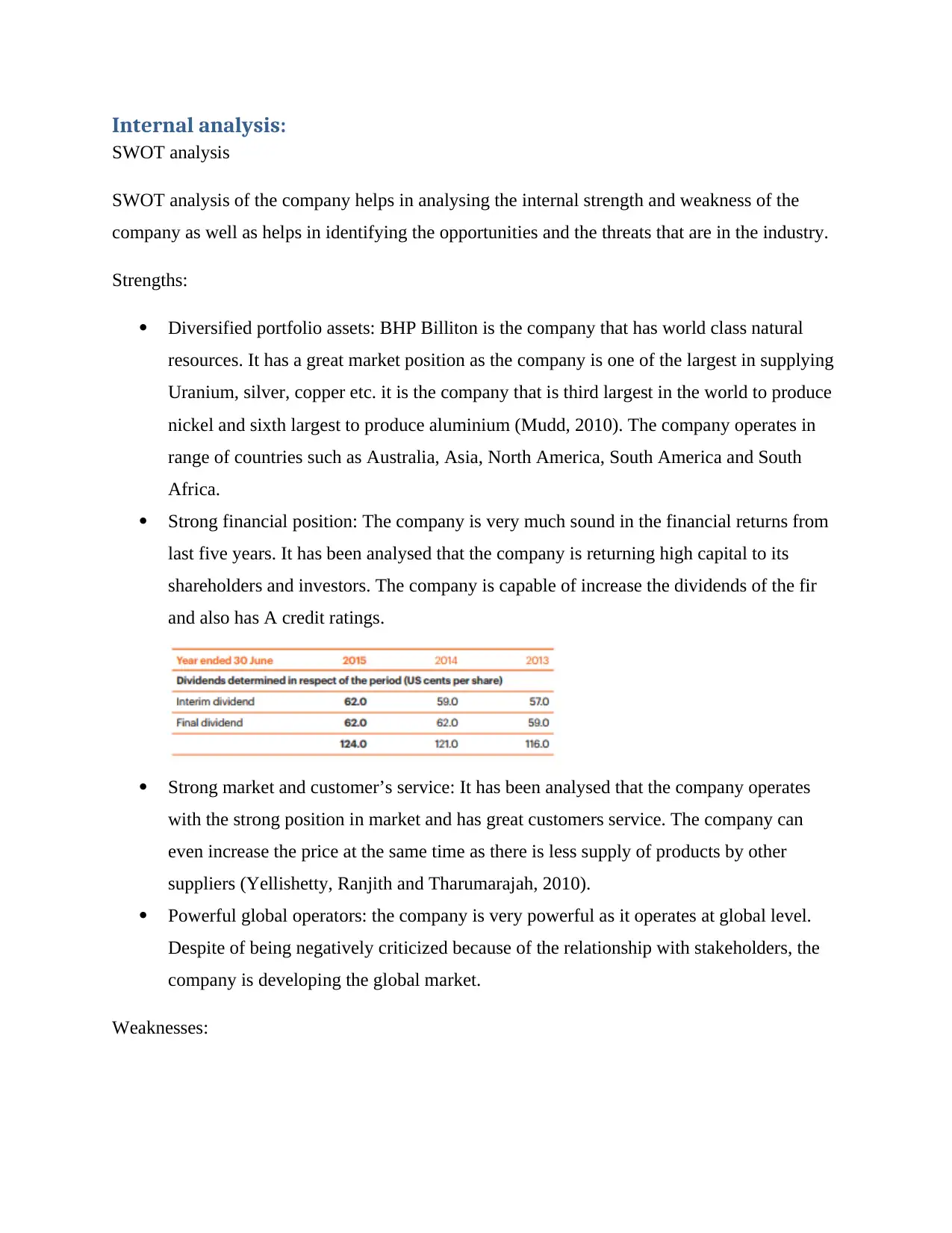
Internal analysis:
SWOT analysis
SWOT analysis of the company helps in analysing the internal strength and weakness of the
company as well as helps in identifying the opportunities and the threats that are in the industry.
Strengths:
Diversified portfolio assets: BHP Billiton is the company that has world class natural
resources. It has a great market position as the company is one of the largest in supplying
Uranium, silver, copper etc. it is the company that is third largest in the world to produce
nickel and sixth largest to produce aluminium (Mudd, 2010). The company operates in
range of countries such as Australia, Asia, North America, South America and South
Africa.
Strong financial position: The company is very much sound in the financial returns from
last five years. It has been analysed that the company is returning high capital to its
shareholders and investors. The company is capable of increase the dividends of the fir
and also has A credit ratings.
Strong market and customer’s service: It has been analysed that the company operates
with the strong position in market and has great customers service. The company can
even increase the price at the same time as there is less supply of products by other
suppliers (Yellishetty, Ranjith and Tharumarajah, 2010).
Powerful global operators: the company is very powerful as it operates at global level.
Despite of being negatively criticized because of the relationship with stakeholders, the
company is developing the global market.
Weaknesses:
SWOT analysis
SWOT analysis of the company helps in analysing the internal strength and weakness of the
company as well as helps in identifying the opportunities and the threats that are in the industry.
Strengths:
Diversified portfolio assets: BHP Billiton is the company that has world class natural
resources. It has a great market position as the company is one of the largest in supplying
Uranium, silver, copper etc. it is the company that is third largest in the world to produce
nickel and sixth largest to produce aluminium (Mudd, 2010). The company operates in
range of countries such as Australia, Asia, North America, South America and South
Africa.
Strong financial position: The company is very much sound in the financial returns from
last five years. It has been analysed that the company is returning high capital to its
shareholders and investors. The company is capable of increase the dividends of the fir
and also has A credit ratings.
Strong market and customer’s service: It has been analysed that the company operates
with the strong position in market and has great customers service. The company can
even increase the price at the same time as there is less supply of products by other
suppliers (Yellishetty, Ranjith and Tharumarajah, 2010).
Powerful global operators: the company is very powerful as it operates at global level.
Despite of being negatively criticized because of the relationship with stakeholders, the
company is developing the global market.
Weaknesses:
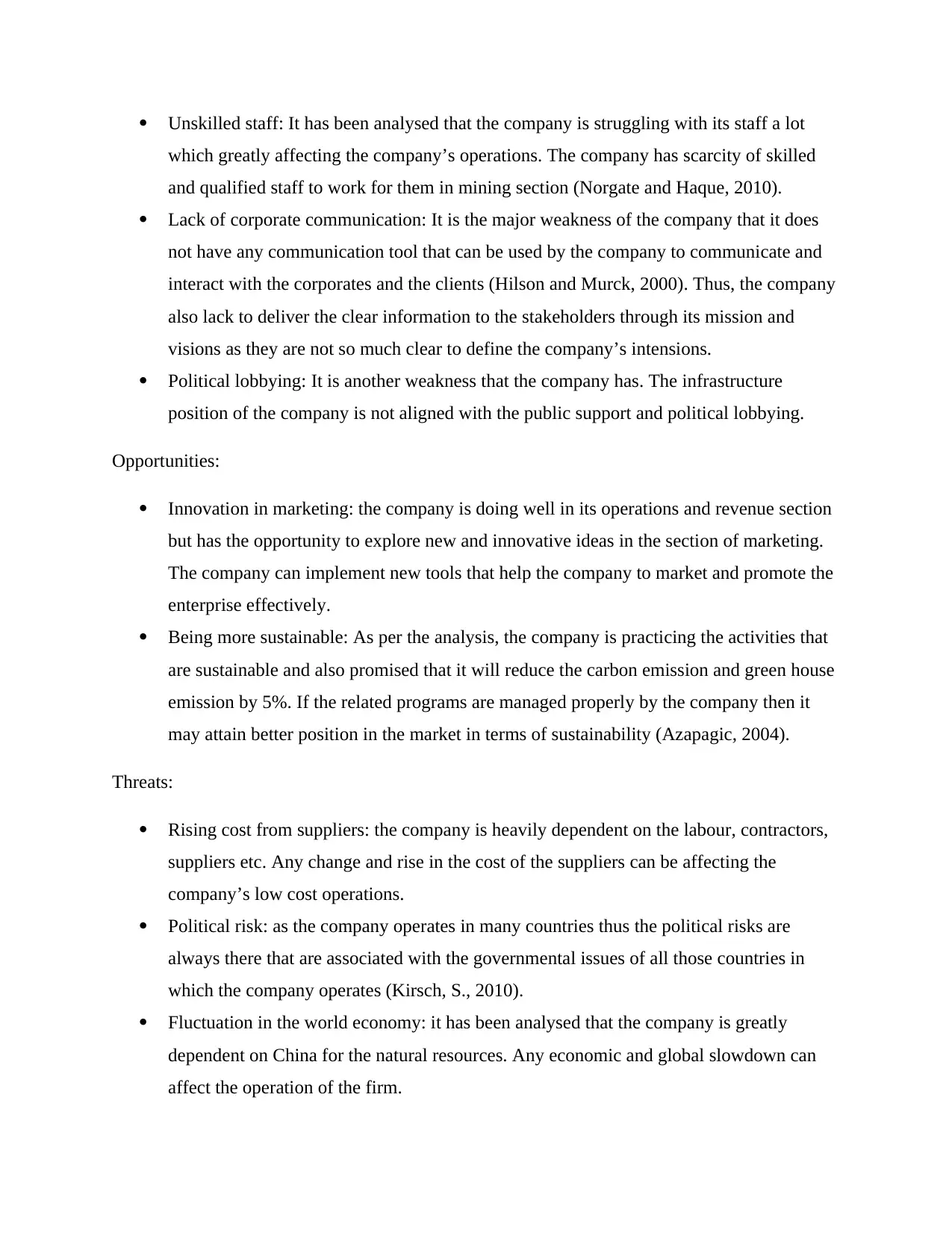
Unskilled staff: It has been analysed that the company is struggling with its staff a lot
which greatly affecting the company’s operations. The company has scarcity of skilled
and qualified staff to work for them in mining section (Norgate and Haque, 2010).
Lack of corporate communication: It is the major weakness of the company that it does
not have any communication tool that can be used by the company to communicate and
interact with the corporates and the clients (Hilson and Murck, 2000). Thus, the company
also lack to deliver the clear information to the stakeholders through its mission and
visions as they are not so much clear to define the company’s intensions.
Political lobbying: It is another weakness that the company has. The infrastructure
position of the company is not aligned with the public support and political lobbying.
Opportunities:
Innovation in marketing: the company is doing well in its operations and revenue section
but has the opportunity to explore new and innovative ideas in the section of marketing.
The company can implement new tools that help the company to market and promote the
enterprise effectively.
Being more sustainable: As per the analysis, the company is practicing the activities that
are sustainable and also promised that it will reduce the carbon emission and green house
emission by 5%. If the related programs are managed properly by the company then it
may attain better position in the market in terms of sustainability (Azapagic, 2004).
Threats:
Rising cost from suppliers: the company is heavily dependent on the labour, contractors,
suppliers etc. Any change and rise in the cost of the suppliers can be affecting the
company’s low cost operations.
Political risk: as the company operates in many countries thus the political risks are
always there that are associated with the governmental issues of all those countries in
which the company operates (Kirsch, S., 2010).
Fluctuation in the world economy: it has been analysed that the company is greatly
dependent on China for the natural resources. Any economic and global slowdown can
affect the operation of the firm.
which greatly affecting the company’s operations. The company has scarcity of skilled
and qualified staff to work for them in mining section (Norgate and Haque, 2010).
Lack of corporate communication: It is the major weakness of the company that it does
not have any communication tool that can be used by the company to communicate and
interact with the corporates and the clients (Hilson and Murck, 2000). Thus, the company
also lack to deliver the clear information to the stakeholders through its mission and
visions as they are not so much clear to define the company’s intensions.
Political lobbying: It is another weakness that the company has. The infrastructure
position of the company is not aligned with the public support and political lobbying.
Opportunities:
Innovation in marketing: the company is doing well in its operations and revenue section
but has the opportunity to explore new and innovative ideas in the section of marketing.
The company can implement new tools that help the company to market and promote the
enterprise effectively.
Being more sustainable: As per the analysis, the company is practicing the activities that
are sustainable and also promised that it will reduce the carbon emission and green house
emission by 5%. If the related programs are managed properly by the company then it
may attain better position in the market in terms of sustainability (Azapagic, 2004).
Threats:
Rising cost from suppliers: the company is heavily dependent on the labour, contractors,
suppliers etc. Any change and rise in the cost of the suppliers can be affecting the
company’s low cost operations.
Political risk: as the company operates in many countries thus the political risks are
always there that are associated with the governmental issues of all those countries in
which the company operates (Kirsch, S., 2010).
Fluctuation in the world economy: it has been analysed that the company is greatly
dependent on China for the natural resources. Any economic and global slowdown can
affect the operation of the firm.
Paraphrase This Document
Need a fresh take? Get an instant paraphrase of this document with our AI Paraphraser
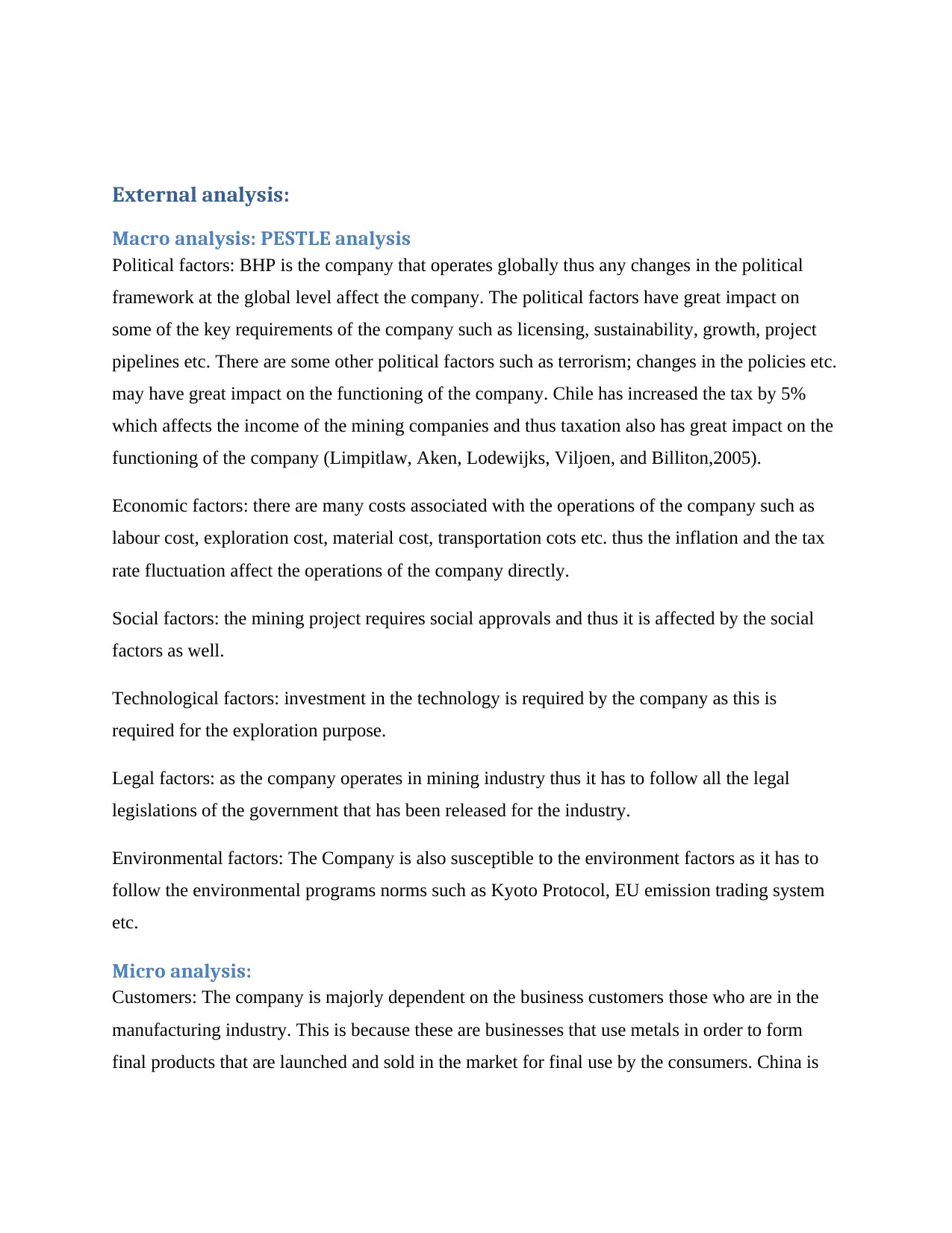
External analysis:
Macro analysis: PESTLE analysis
Political factors: BHP is the company that operates globally thus any changes in the political
framework at the global level affect the company. The political factors have great impact on
some of the key requirements of the company such as licensing, sustainability, growth, project
pipelines etc. There are some other political factors such as terrorism; changes in the policies etc.
may have great impact on the functioning of the company. Chile has increased the tax by 5%
which affects the income of the mining companies and thus taxation also has great impact on the
functioning of the company (Limpitlaw, Aken, Lodewijks, Viljoen, and Billiton,2005).
Economic factors: there are many costs associated with the operations of the company such as
labour cost, exploration cost, material cost, transportation cots etc. thus the inflation and the tax
rate fluctuation affect the operations of the company directly.
Social factors: the mining project requires social approvals and thus it is affected by the social
factors as well.
Technological factors: investment in the technology is required by the company as this is
required for the exploration purpose.
Legal factors: as the company operates in mining industry thus it has to follow all the legal
legislations of the government that has been released for the industry.
Environmental factors: The Company is also susceptible to the environment factors as it has to
follow the environmental programs norms such as Kyoto Protocol, EU emission trading system
etc.
Micro analysis:
Customers: The company is majorly dependent on the business customers those who are in the
manufacturing industry. This is because these are businesses that use metals in order to form
final products that are launched and sold in the market for final use by the consumers. China is
Macro analysis: PESTLE analysis
Political factors: BHP is the company that operates globally thus any changes in the political
framework at the global level affect the company. The political factors have great impact on
some of the key requirements of the company such as licensing, sustainability, growth, project
pipelines etc. There are some other political factors such as terrorism; changes in the policies etc.
may have great impact on the functioning of the company. Chile has increased the tax by 5%
which affects the income of the mining companies and thus taxation also has great impact on the
functioning of the company (Limpitlaw, Aken, Lodewijks, Viljoen, and Billiton,2005).
Economic factors: there are many costs associated with the operations of the company such as
labour cost, exploration cost, material cost, transportation cots etc. thus the inflation and the tax
rate fluctuation affect the operations of the company directly.
Social factors: the mining project requires social approvals and thus it is affected by the social
factors as well.
Technological factors: investment in the technology is required by the company as this is
required for the exploration purpose.
Legal factors: as the company operates in mining industry thus it has to follow all the legal
legislations of the government that has been released for the industry.
Environmental factors: The Company is also susceptible to the environment factors as it has to
follow the environmental programs norms such as Kyoto Protocol, EU emission trading system
etc.
Micro analysis:
Customers: The company is majorly dependent on the business customers those who are in the
manufacturing industry. This is because these are businesses that use metals in order to form
final products that are launched and sold in the market for final use by the consumers. China is
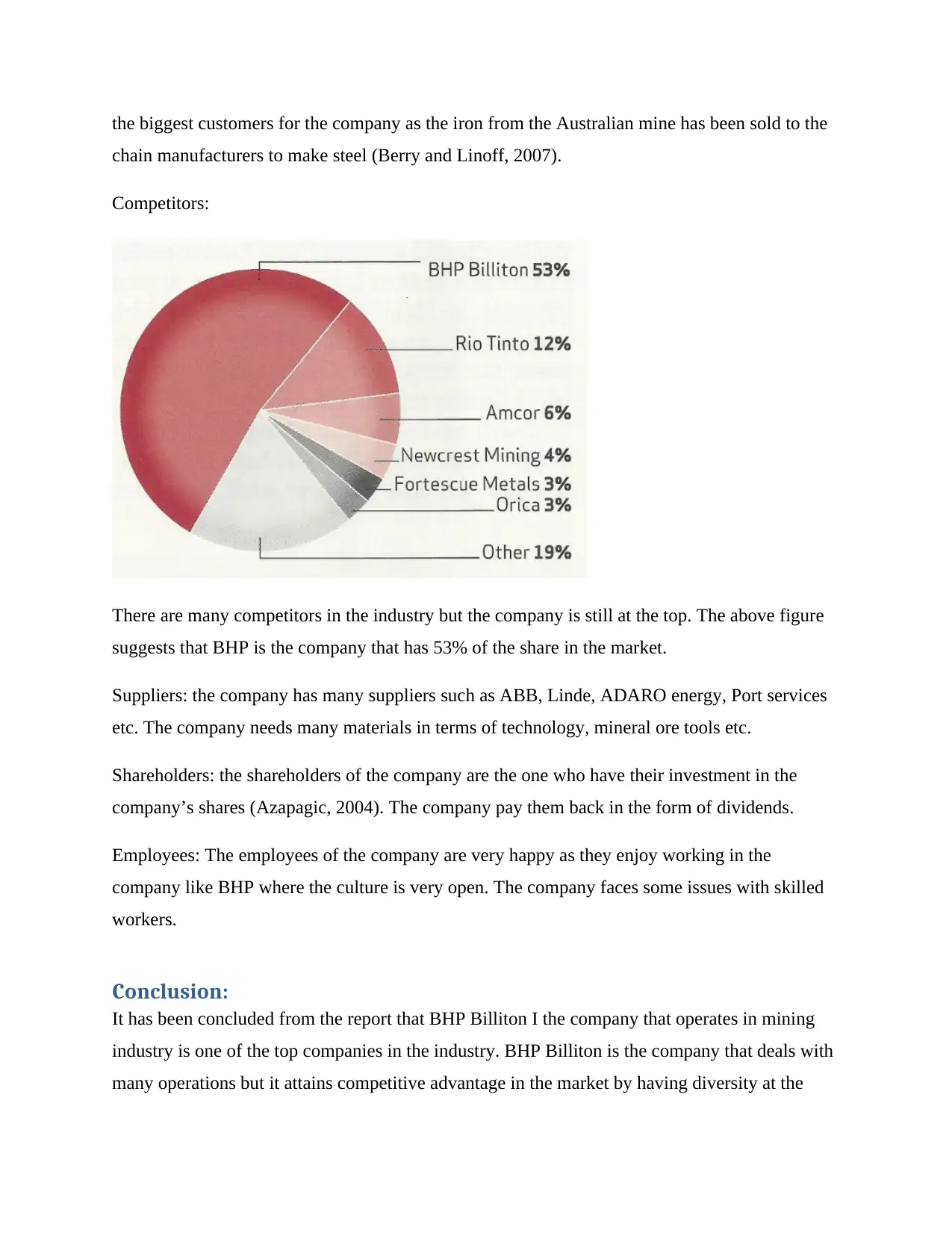
the biggest customers for the company as the iron from the Australian mine has been sold to the
chain manufacturers to make steel (Berry and Linoff, 2007).
Competitors:
There are many competitors in the industry but the company is still at the top. The above figure
suggests that BHP is the company that has 53% of the share in the market.
Suppliers: the company has many suppliers such as ABB, Linde, ADARO energy, Port services
etc. The company needs many materials in terms of technology, mineral ore tools etc.
Shareholders: the shareholders of the company are the one who have their investment in the
company’s shares (Azapagic, 2004). The company pay them back in the form of dividends.
Employees: The employees of the company are very happy as they enjoy working in the
company like BHP where the culture is very open. The company faces some issues with skilled
workers.
Conclusion:
It has been concluded from the report that BHP Billiton I the company that operates in mining
industry is one of the top companies in the industry. BHP Billiton is the company that deals with
many operations but it attains competitive advantage in the market by having diversity at the
chain manufacturers to make steel (Berry and Linoff, 2007).
Competitors:
There are many competitors in the industry but the company is still at the top. The above figure
suggests that BHP is the company that has 53% of the share in the market.
Suppliers: the company has many suppliers such as ABB, Linde, ADARO energy, Port services
etc. The company needs many materials in terms of technology, mineral ore tools etc.
Shareholders: the shareholders of the company are the one who have their investment in the
company’s shares (Azapagic, 2004). The company pay them back in the form of dividends.
Employees: The employees of the company are very happy as they enjoy working in the
company like BHP where the culture is very open. The company faces some issues with skilled
workers.
Conclusion:
It has been concluded from the report that BHP Billiton I the company that operates in mining
industry is one of the top companies in the industry. BHP Billiton is the company that deals with
many operations but it attains competitive advantage in the market by having diversity at the
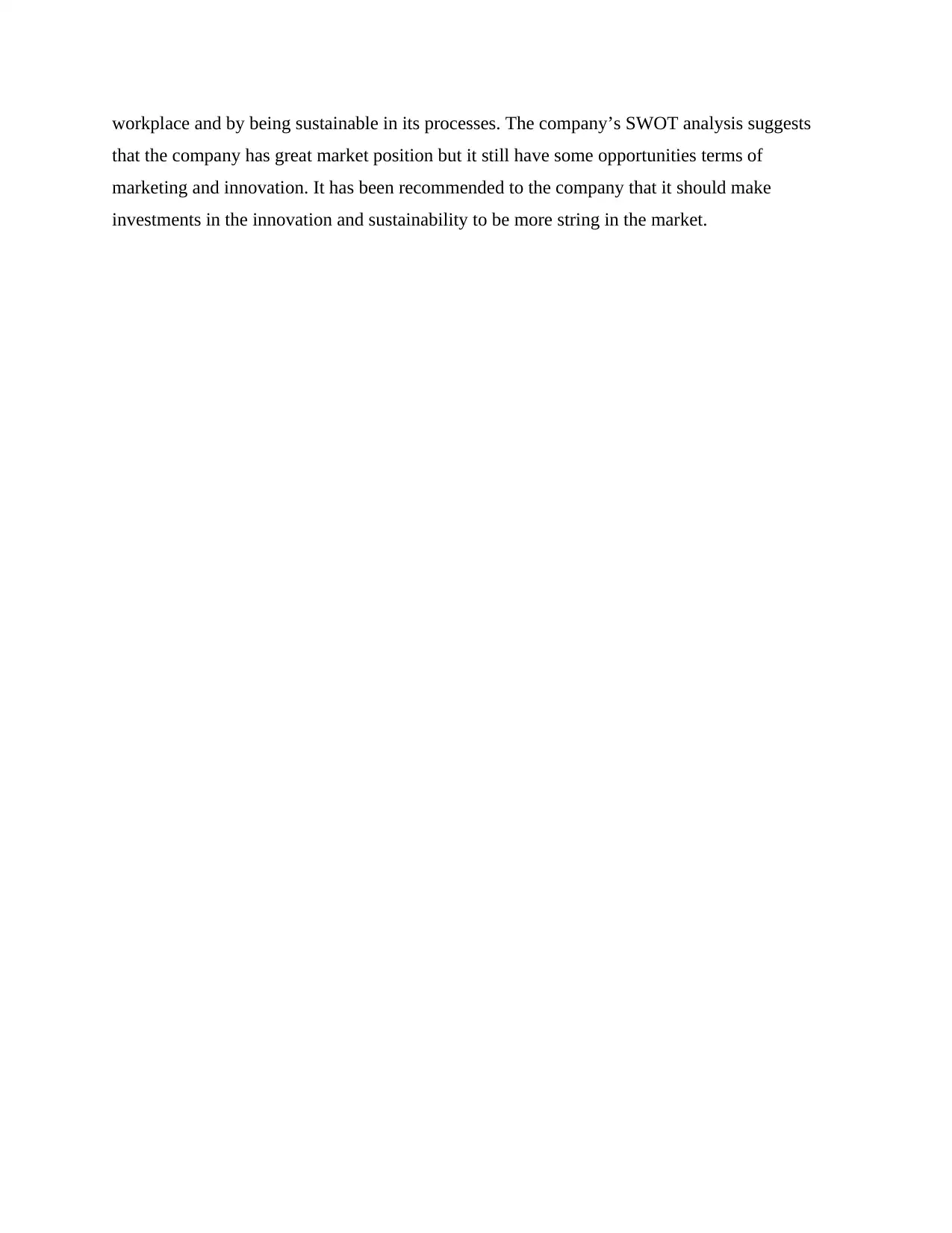
workplace and by being sustainable in its processes. The company’s SWOT analysis suggests
that the company has great market position but it still have some opportunities terms of
marketing and innovation. It has been recommended to the company that it should make
investments in the innovation and sustainability to be more string in the market.
that the company has great market position but it still have some opportunities terms of
marketing and innovation. It has been recommended to the company that it should make
investments in the innovation and sustainability to be more string in the market.
Secure Best Marks with AI Grader
Need help grading? Try our AI Grader for instant feedback on your assignments.
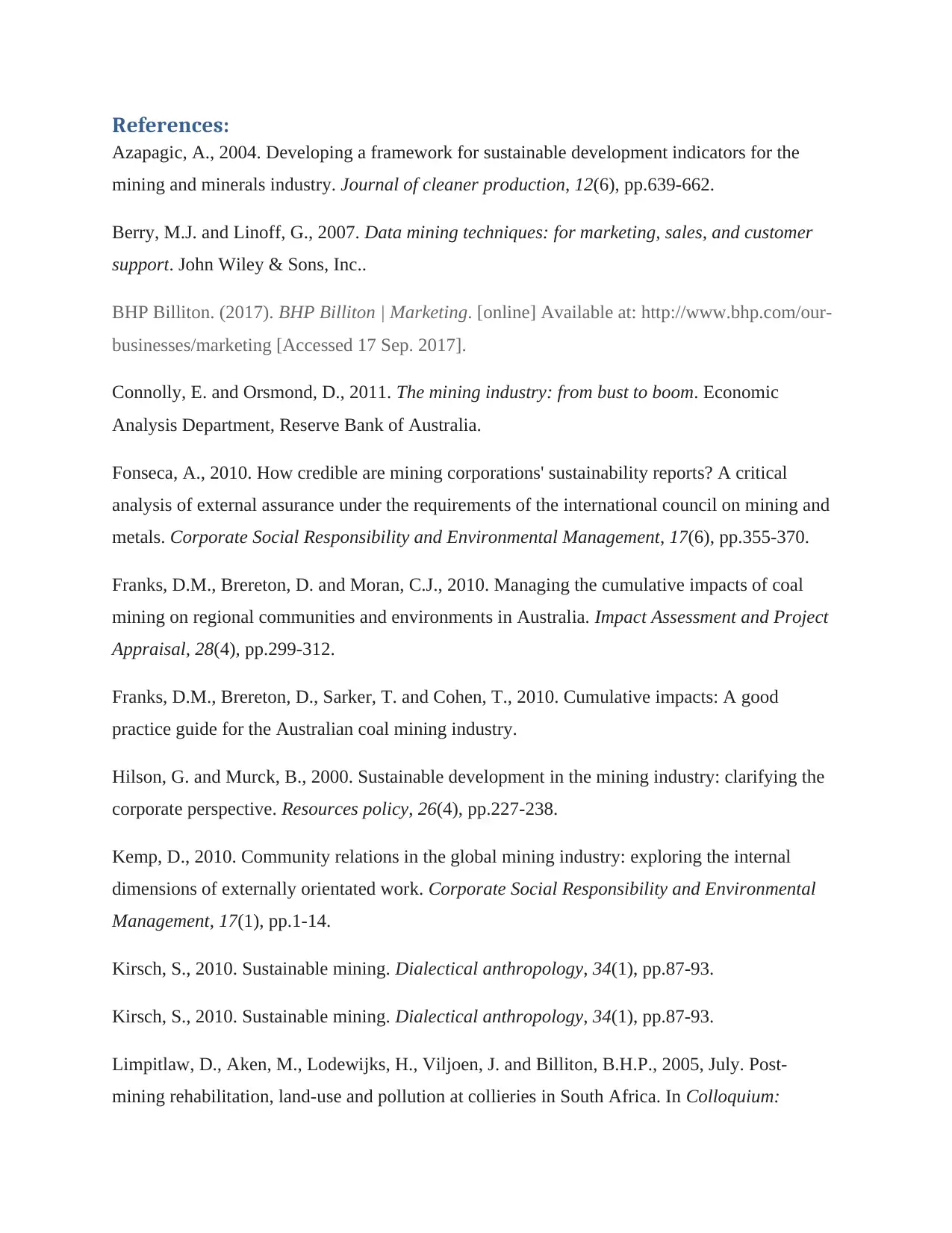
References:
Azapagic, A., 2004. Developing a framework for sustainable development indicators for the
mining and minerals industry. Journal of cleaner production, 12(6), pp.639-662.
Berry, M.J. and Linoff, G., 2007. Data mining techniques: for marketing, sales, and customer
support. John Wiley & Sons, Inc..
BHP Billiton. (2017). BHP Billiton | Marketing. [online] Available at: http://www.bhp.com/our-
businesses/marketing [Accessed 17 Sep. 2017].
Connolly, E. and Orsmond, D., 2011. The mining industry: from bust to boom. Economic
Analysis Department, Reserve Bank of Australia.
Fonseca, A., 2010. How credible are mining corporations' sustainability reports? A critical
analysis of external assurance under the requirements of the international council on mining and
metals. Corporate Social Responsibility and Environmental Management, 17(6), pp.355-370.
Franks, D.M., Brereton, D. and Moran, C.J., 2010. Managing the cumulative impacts of coal
mining on regional communities and environments in Australia. Impact Assessment and Project
Appraisal, 28(4), pp.299-312.
Franks, D.M., Brereton, D., Sarker, T. and Cohen, T., 2010. Cumulative impacts: A good
practice guide for the Australian coal mining industry.
Hilson, G. and Murck, B., 2000. Sustainable development in the mining industry: clarifying the
corporate perspective. Resources policy, 26(4), pp.227-238.
Kemp, D., 2010. Community relations in the global mining industry: exploring the internal
dimensions of externally orientated work. Corporate Social Responsibility and Environmental
Management, 17(1), pp.1-14.
Kirsch, S., 2010. Sustainable mining. Dialectical anthropology, 34(1), pp.87-93.
Kirsch, S., 2010. Sustainable mining. Dialectical anthropology, 34(1), pp.87-93.
Limpitlaw, D., Aken, M., Lodewijks, H., Viljoen, J. and Billiton, B.H.P., 2005, July. Post-
mining rehabilitation, land-use and pollution at collieries in South Africa. In Colloquium:
Azapagic, A., 2004. Developing a framework for sustainable development indicators for the
mining and minerals industry. Journal of cleaner production, 12(6), pp.639-662.
Berry, M.J. and Linoff, G., 2007. Data mining techniques: for marketing, sales, and customer
support. John Wiley & Sons, Inc..
BHP Billiton. (2017). BHP Billiton | Marketing. [online] Available at: http://www.bhp.com/our-
businesses/marketing [Accessed 17 Sep. 2017].
Connolly, E. and Orsmond, D., 2011. The mining industry: from bust to boom. Economic
Analysis Department, Reserve Bank of Australia.
Fonseca, A., 2010. How credible are mining corporations' sustainability reports? A critical
analysis of external assurance under the requirements of the international council on mining and
metals. Corporate Social Responsibility and Environmental Management, 17(6), pp.355-370.
Franks, D.M., Brereton, D. and Moran, C.J., 2010. Managing the cumulative impacts of coal
mining on regional communities and environments in Australia. Impact Assessment and Project
Appraisal, 28(4), pp.299-312.
Franks, D.M., Brereton, D., Sarker, T. and Cohen, T., 2010. Cumulative impacts: A good
practice guide for the Australian coal mining industry.
Hilson, G. and Murck, B., 2000. Sustainable development in the mining industry: clarifying the
corporate perspective. Resources policy, 26(4), pp.227-238.
Kemp, D., 2010. Community relations in the global mining industry: exploring the internal
dimensions of externally orientated work. Corporate Social Responsibility and Environmental
Management, 17(1), pp.1-14.
Kirsch, S., 2010. Sustainable mining. Dialectical anthropology, 34(1), pp.87-93.
Kirsch, S., 2010. Sustainable mining. Dialectical anthropology, 34(1), pp.87-93.
Limpitlaw, D., Aken, M., Lodewijks, H., Viljoen, J. and Billiton, B.H.P., 2005, July. Post-
mining rehabilitation, land-use and pollution at collieries in South Africa. In Colloquium:
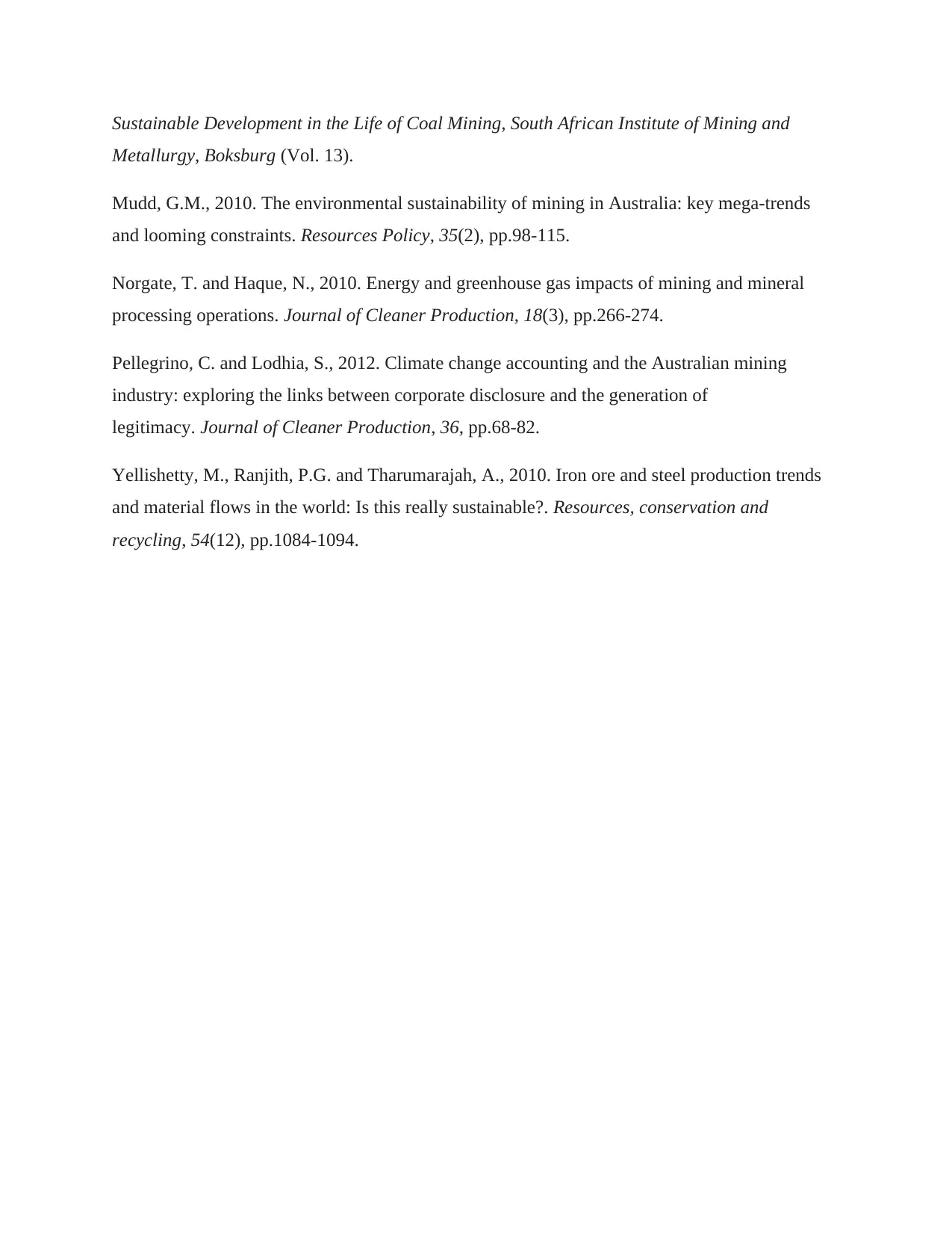
Sustainable Development in the Life of Coal Mining, South African Institute of Mining and
Metallurgy, Boksburg (Vol. 13).
Mudd, G.M., 2010. The environmental sustainability of mining in Australia: key mega-trends
and looming constraints. Resources Policy, 35(2), pp.98-115.
Norgate, T. and Haque, N., 2010. Energy and greenhouse gas impacts of mining and mineral
processing operations. Journal of Cleaner Production, 18(3), pp.266-274.
Pellegrino, C. and Lodhia, S., 2012. Climate change accounting and the Australian mining
industry: exploring the links between corporate disclosure and the generation of
legitimacy. Journal of Cleaner Production, 36, pp.68-82.
Yellishetty, M., Ranjith, P.G. and Tharumarajah, A., 2010. Iron ore and steel production trends
and material flows in the world: Is this really sustainable?. Resources, conservation and
recycling, 54(12), pp.1084-1094.
Metallurgy, Boksburg (Vol. 13).
Mudd, G.M., 2010. The environmental sustainability of mining in Australia: key mega-trends
and looming constraints. Resources Policy, 35(2), pp.98-115.
Norgate, T. and Haque, N., 2010. Energy and greenhouse gas impacts of mining and mineral
processing operations. Journal of Cleaner Production, 18(3), pp.266-274.
Pellegrino, C. and Lodhia, S., 2012. Climate change accounting and the Australian mining
industry: exploring the links between corporate disclosure and the generation of
legitimacy. Journal of Cleaner Production, 36, pp.68-82.
Yellishetty, M., Ranjith, P.G. and Tharumarajah, A., 2010. Iron ore and steel production trends
and material flows in the world: Is this really sustainable?. Resources, conservation and
recycling, 54(12), pp.1084-1094.
1 out of 12
Related Documents
Your All-in-One AI-Powered Toolkit for Academic Success.
+13062052269
info@desklib.com
Available 24*7 on WhatsApp / Email
![[object Object]](/_next/static/media/star-bottom.7253800d.svg)
Unlock your academic potential
© 2024 | Zucol Services PVT LTD | All rights reserved.





